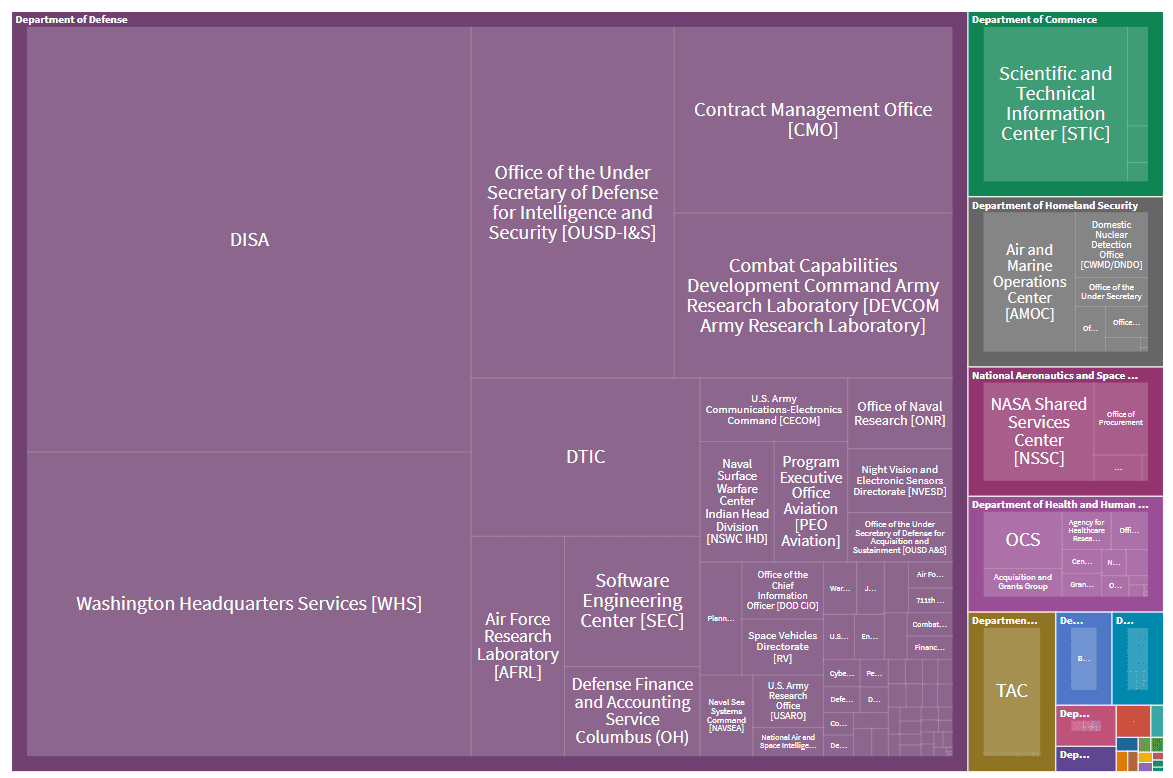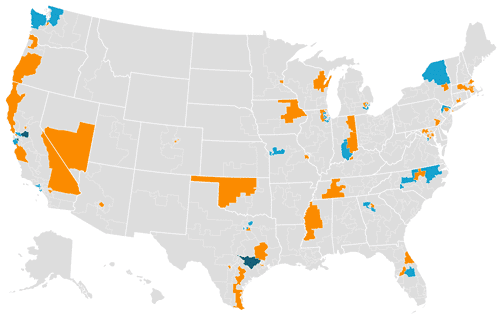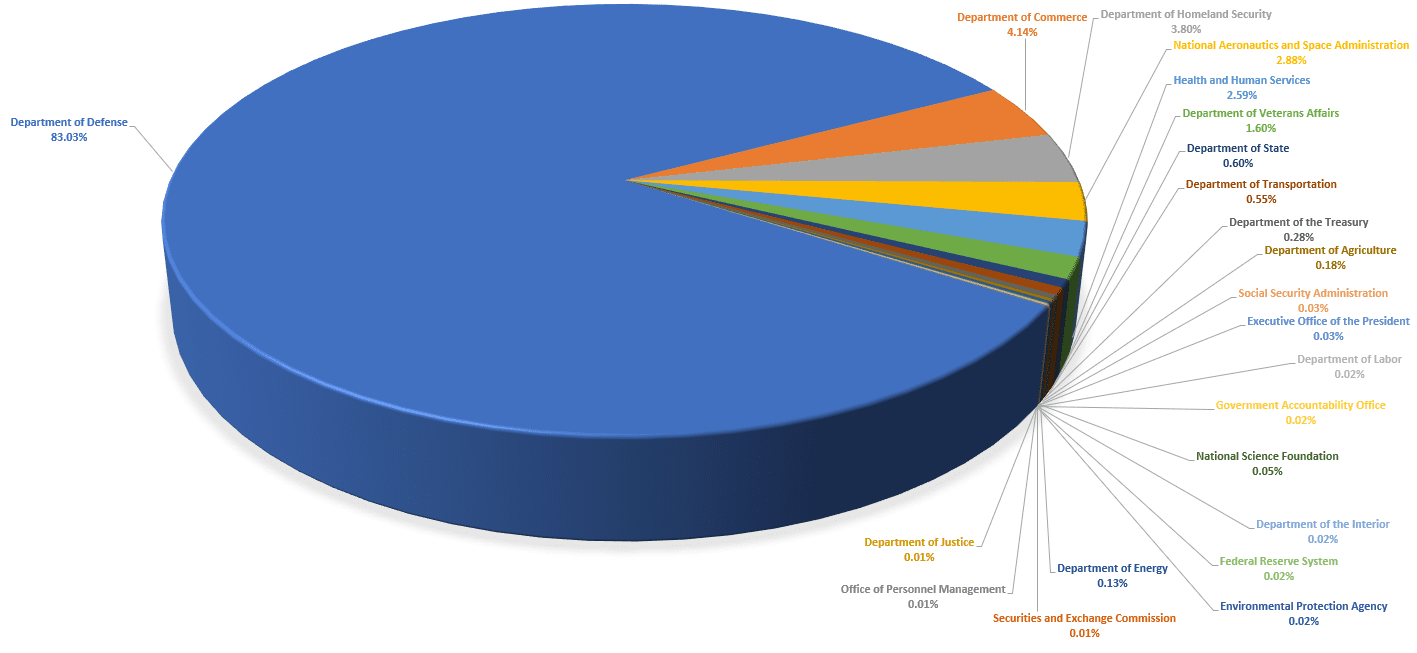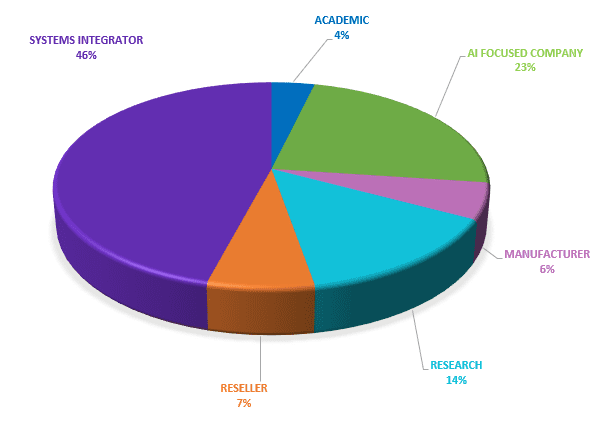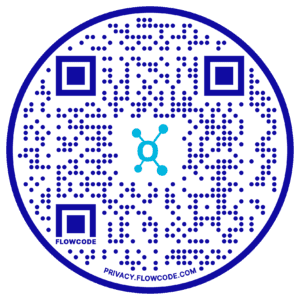by Salma Ismaiel, Michael Crosby, Harris Beringer, and the Leadership Connect Data Science Team
November 2021
KEY FINDINGS
- Agency: DoD is close to 80% of AI spend, with the Defense Information Systems Agency (DISA) taking the biggest slice of the pie.
- Vendors: The majority of awards are going to traditional System Integrators (almost 50%).
- Congressional: Most sponsors on bills impacting AI are not part of specific committee or caucuses involved in AI.
For Government
We identify the offices and staff who are using AI today to act as subject-matter experts for policy makers and agency leaders contemplating the use of AI technology.
For Contractors
We provide a roadmap of every office and their staff involved in AI purchasing.
For AI Vendors not working with the Federal Government
We identify who to talk to within government, and current contractors to approach for partnership.
In his remarks to the UN on Sept. 21, 2021, President Biden cited the need for partnerships with democratic countries to leverage AI to solve problems and advance human freedom. Administration initiatives such as AI.gov, the National Artificial Intelligence Research Resource Task Force and National Security Commission on AI demonstrate the increasing focus on AI.
We look at the past 5 years of spend and show who is involved in each contract.
Overview of AI Spending by Agency
As the largest purchaser of technology within the federal government, it should be no surprise the DoD is close to 80% of AI spend. Offices such as the Joint Artificial Intelligence Center (JAIC) are critical to AI decision-making at the DoD. What may be surprising is the breadth of other agencies involved. Commerce, DHS, NASA, HHS, VA, and State are key players among the 20 other agencies who have AI-driven spend.
Chart of Agencies Involved in AI
Agency |
Spend |
| Department of Defense | $969,668,551 |
| Department of Commerce | $48,340,431 |
| Department of Homeland Security | $44,359,945 |
| National Aeronautics and Space Administration | $33,674,720 |
| Health and Human Services | $30,188,962 |
| Department of Veterans Affairs | $18,688,296 |
| Department of State | $6,975,680 |
| Department of Transportation | $6,386,409 |
| Department of the Treasury | $3,309,956 |
| Department of Agriculture | $2,043,843 |
| Department of Energy | $1,487,246 |
| National Science Foundation | $534,261 |
| Executive Office of the President | $405,330 |
| Social Security Administration | $314,910 |
| Department of Labor | $284,469 |
| Government Accountability Office | $253,265 |
| Department of the Interior | $245,538 |
| Federal Reserve System | $193,489 |
| Environmental Protection Agency | $177,337 |
| Securities and Exchange Commission | $116,317 |
| Office of Personnel Management | $103,360 |
| Department of Justice | $66,021 |
Overview of AI Spending by Office
Looking at the Agency level is great for a high-level view, but if you want to talk to the decision-makers and staff, you need to be at the office level. In just the DoD, there are well over 1,000 key people involved in AI-focused decision-making. There are also over 100 individual offices directly spending on AI.
Click the image below to view an interactive visualization
Chart of Top 20 Offices Involved in AI (with leaders and staff for each office)
Subscription required to load office profiles
Overview of AI Vendors
We identified over 200 vendors involved in AI awards with the federal government. These include AI-focused companies, research-focused companies and non-profits, System Integrators, and universities. The Biden Administration has committed funds to research so universities and research organizations should come as no surprise. However, what may be surprising is that the majority of awards are going to traditional System Integrators (almost 50%). Since sub-contracting data is not publicly available, there are likely more AI vendors “working” with the federal government.
The top 50 vendors, arranged by type
Click the image below to view an interactive visualization
Chart of AI Vendors not doing business with the Federal Government as a primary contractor (G2)
| MATLAB |
| RapidMiner |
| Alteryx |
| Rstudio |
| Anaconda |
| Kraken |
| BigML |
| DataRobot |
| SAS Enterprise Miner |
| Civis |
| Eggplant |
| Theano |
Chart of Top AI Vendors (G2)
| AI & Machine Learning Operationalization Software |
| Algorithmia |
| InRule |
| Cortex Certifai |
| IBM Watson Studio |
| UbiOps |
| cnvrg.io |
| Conversational Intelligence Software |
| ServiceNow Now Platform |
| IBM Watson Assistant |
| ManyChat |
| Qualified |
| Verloop.io |
| Zendesk Support Suite |
| Appy Pie |
| Drift |
| Birdeye |
| Userlike |
| Conversocial |
| Ada |
| ultimate.ai |
| Conversica |
| e-bot7 |
| Azure Text to Speech API |
| Microsoft Knowledge Exploration Service |
| Microsoft Bing Spell Check API |
| NLTK |
| Amazon Polly |
| Data Labeling Software |
| SuperAnnotate |
| V7 |
| Appen |
| Amazon Sagemaker Ground Truth |
| Datasaur |
| Innotescus Video and Image Annotation Platform |
| Dataloop |
| Playment |
| CloudFactory |
| DefinedCrowd |
| Diffgram Training Data Software |
| Machine Learning Operationalization Software |
| MLOps |
| Neptune.ai |
| Seldon |
| Data Science and Machine Learning Platforms |
| Peltarion Platform |
| Google Cloud AI Platform |
| TIMi Suite |
| Azure Machine Learning Studio |
| IBM SPSS Modeler |
| Explorium |
| IBM Decision Optimization |
| Amazon SageMaker |
| H20 |
| Dataiku DSS |
| Box Skills |
| Qubole |
| Google Cloud AutoML |
| KNIME Analytics Platform |
| FloydHub |
| Deep Cognition |
| Deepnote |
| Oracle Data Science Cloud Service |
| Domino |
| Dash |
| DataCanvas |
| IBM Cloud Park for Data |
| Peak.ai Abnormal Demand Response |
| H20 Driverless AI |
| Pecan |
| Stratifyd |
| Datagran |
| Infosys Nia |
| JADBio AutoML |
| Kortical |
| Open Text Magellan |
| PerceptiLabs |
| Analance Advanced Analytics |
| Appier AIXON |
| Artivatic |
| Ayasdi |
| C3 AI Suite |
| Cloudera Data Enigneering |
| DeepDetect |
| Synthetic Data Software |
| MDClone |
| YData |
| Deep Learning Software |
| Keras |
| TFLearn |
| IntSig OCR Solutions |
| OpenCV |
| Syte |
| Google Cloud Vision API |
| Express Scribe |
| Kaldi |
| Jasper |
| Microsoft Speaker Recognition API |
| Microsoft Bing Speech API |
| Amazon Rekognition |
| Machine Learning |
| Xilinx |
| scikit-learn |
| Personalizer |
| Google Cloud TPU |
| Amazon Personalize |
| machine-learning |
| Python |
| GoLearn |
| MLIib |
| Amazon Forecast |
| Weka |
| Kubeflow |
| XGBoost |
| Crab |
| Mahout |
| Annoy |
| Beeze |
| Vowpal Wabbit |
| Cloud Talent Solution |
| SHARK |
| ByteBridge |
| Dlib Machine Learning |
| Pattern |
| Recombee |
| Sparkling Water |
| SuperLearner |
| Azure Custom Decision Service |
| Figaro |
| Mixtend |
| PyTorch |
| Apache SAMOA |
| Commerce Cloud Einstein |
| Conjecture |
| Crossing Minds API |
Congressional Leaders Shaping Policy & Legislation
AI is clearly a focus area for the administration, but who calls the shots on the Hill? You might think tech and academic centers would dominate policy-making, but that is not the case.
We put together a District Map of where those policy makers reside. Certainly, coastal states dominate, but it’s not all Silicon Valley, Silicon Alley, and other tech centers.
What is notable for policy makers is that the vast majority of sponsors on bills impacting AI are not part of specific committee or caucuses involved in AI.
Leaders and staff comprised a group close to 200 key influencers on the Hill.
Future Updates
As contracts are released and money is spent, we will be closely monitoring the impact of those dollars in AI. Understandably the market is fluid, and we want to be prepared for what the contracting world needs. Please feel free to submit updates or suggestions.
About Our Data
Leadership Connect is the first service to use human-driven research and AI to connect agency leaders & staff to awards and opportunities for government and contractors. We are also the first to do the same for policy and staff. We used our database to export awards driven by keyword, known offices, vendors, and NAICS codes to produce a list of awards. This same search is available in our product. We did the same in looking at AI-focused entities on the Hill along with legislation to produce a list of leaders who are involved in AI-policy.


